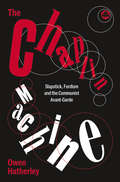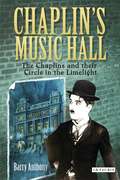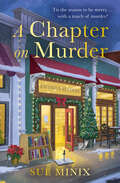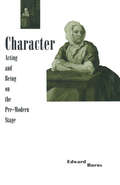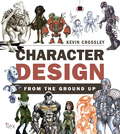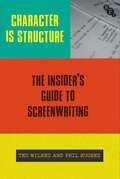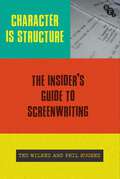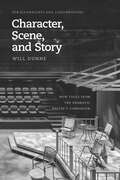- Table View
- List View
The Chaplin Machine: Slapstick, Fordism and the Communist Avant-Garde
by Owen HatherleyCould Buster Keaton have starred in Battleship Potemkin?*BR**BR*Did Trotsky plan to write the great Soviet comedy?*BR**BR*And why did Lenin love circus clowns?*BR**BR*The Chaplin Machine reveals the lighter side of the Communist avant-garde and its unlikely passion for American slapstick. Set against the backdrop of the great Russian revolutionary experiment, Owen Hatherley tells the tragic-comedic story of the cinema, art and architecture of the early 20th Century and spotlights the unlikely intersections of East and West.
Chaplin's Music Hall: The Chaplins and their Circle in the Limelight (20120930 Ser. #20120930)
by Barry AnthonyCharlie Chaplin grew up in and around the music hall. His parents, aunt and their friends all earned their precarious livings on the stage and Chaplin himself started out his career touring music halls with a dance troupe. His experiences of the culture of the music hall were a major influence, shaping his style of acting and the films he made, most famously Limelight, which tells the story of a failing variety performer and which evoked painful memories of his own past. Chaplin was horrified to see how performers' lives were ruined when their audience turned against them and he was relieved to exchange the stresses of live performance for screen comedy. Barry Anthony here tells the story of the lives and careers of Chaplin's family and their music-hall circle – from 'dashing' Eva Lester to the great Fred Karno and from Chaplin's parents Hannah Hill and Charles Chaplin to 'The Great Calvero' himself. He reveals the difficult and often-tragic lives of London's variety community in the late-Victorian and Edwardian years, a time of great change in the music hall and entertainment scene, and in doing so sheds important new light on the inspiration behind Chaplin's genius, providing a fascinatingly fresh perspective on this popular cultural icon of the twentieth century.
A Chapter on Murder (The Bookstore Mystery Series)
by Sue MinixI loved writing murder mysteries, until I was thrust into the centre of one …
Character, Acting and Being on the Pre-modern Stage
by Edward BurnsAn analysis of acting and characterization on stage, covering theories of character from Aristotle to Brecht and approaches from formalism to post structuralism. The Early Theatre Group have, over the last 5 years, used an experimental approach to performing some of the plays written about here.
Character Breakdown
by Zawe AshtonCult heroine Zawe Ashton brings us a unique look at life, work and the absurdities of contemporary lifeZawe Ashton has been acting since she was six. She has played many different roles, from ‘cute little girl’ to ‘assassin with attitude', Oscar Wilde’s Salome to St Trinian’s schoolgirl by way of Fresh Meat’s Vod. To stay sane, an actress must tread a high-wire between life and art, keep sight of where a character ends and the real person begins. So she doesn’t lose herself completely. In Character Breakdown, Zawe scrolls through a version of her life. Or is it a version of her art? Or something in between. In it, she encounters glamour, horror, absurdity and questions like: is a life spent more on performance than reality any life at all?
Character Costume Figure Drawing: Step-by-Step Drawing Methods for Theatre Costume Designers
by Tan HuaixiangCharacter Costume Figure Drawing is an essential guide that will improve your drawing skills and costume renderings. Step-by-step visuals illustrate the how-tos of drawing body parts, costumes, accessories, faces, children, and different character archetypes, such as maternal, elderly, sassy, sexy, and evil. By focusing on the foundations of drawing bodies, including body proportion, bone structure, body masses, facial expressions, and appendages, this guide shows you how to develop sketches from stick figures to full-blown characters. The third edition features a new chapter, Digital Mixed Media Costume Rendering. This chapter introduces the basic usages of Photoshop tools to enhance and improve costume designs, in order to provide easy delivery design ideas to the director and design team, provide easy changes and alterations during the design process, virtually apply actual fabric swatches over costume sketches, and help visualize lighting effects.
Character Costume Figure Drawing: Step-by-Step Drawing Methods for Theatre Costume Designers
by Tan HuaixiangCharacter Costume Figure Drawing is an essential guide that will improve your drawing skills and costume renderings. Step-by-step visuals illustrate the how-tos of drawing body parts, costumes, accessories, faces, children, and different character archetypes, such as maternal, elderly, sassy, sexy, and evil. By focusing on the foundations of drawing bodies, including body proportion, bone structure, body masses, facial expressions, and appendages, this guide shows you how to develop sketches from stick figures to full-blown characters. The third edition features a new chapter, Digital Mixed Media Costume Rendering. This chapter introduces the basic usages of Photoshop tools to enhance and improve costume designs, in order to provide easy delivery design ideas to the director and design team, provide easy changes and alterations during the design process, virtually apply actual fabric swatches over costume sketches, and help visualize lighting effects.
Character Design from the Ground Up: Make Your Sketches Come to Life
by Kevin CrossleyAll stories have characters, and whether its a film, game, book, or comic, all characters need to be designed. Character design has become a distinct discipline in the entertainment industry, and character designers are employed by film and game companies across the globe to bring life to scripts and ideas. In this book, illustrator and character designer Kevin Crossley provides a complete overview of character design. Starting with the basics of materials, equipment, and sofware, Kevin will explain the processes professional character designers follow to develop characters for publishing, games, and film. From ideas and thumbnails, anatomy and reference, through effective drawing, 3D mock-ups and full turnarounds, Kev explains how a character designer works to achieve professional results.
Character is Structure: The Insider’s Guide to Screenwriting
by Ted Wilkes Phil HughesThis book seeks to reshape the way that writers think about constructing their story, looking at the subject from the inside out. Often practitioners and theorists examine work through the separate lenses of character and/or structure and then bring them together. Within this book, authors Hughes and Wilkes argue that character is structure and one without the other makes for a dissatisfying narrative.Through detailed case studies on films that span all genres, from mainstream franchises like The Hunger Games (2012-2015) and Shrek (2001-2010) to art house films such as Toto Le Heros (1991) and Eraserhead (1977), the authors reveal the dramatic imperative behind the central choices or dilemmas faced by every protagonist in every classic feature length narrative. They argue there is only one of five choices that any writer must make in inventing that key transition from the protagonist's ordinary world into the adventure that will form the heart of their story.Using the universal language of folk and fairy stories, this book gives writers and students a clear framework through which they can reference and improve their own storytelling. In doing so, it enables both the novice and experienced screenwriter to tell their story in the most authentic and impactful way, while keeping their protagonist at the heart of the narrative.
Character is Structure: The Insider’s Guide to Screenwriting
by Ted Wilkes Phil HughesThis book seeks to reshape the way that writers think about constructing their story, looking at the subject from the inside out. Often practitioners and theorists examine work through the separate lenses of character and/or structure and then bring them together. Within this book, authors Hughes and Wilkes argue that character is structure and one without the other makes for a dissatisfying narrative.Through detailed case studies on films that span all genres, from mainstream franchises like The Hunger Games (2012-2015) and Shrek (2001-2010) to art house films such as Toto Le Heros (1991) and Eraserhead (1977), the authors reveal the dramatic imperative behind the central choices or dilemmas faced by every protagonist in every classic feature length narrative. They argue there is only one of five choices that any writer must make in inventing that key transition from the protagonist's ordinary world into the adventure that will form the heart of their story.Using the universal language of folk and fairy stories, this book gives writers and students a clear framework through which they can reference and improve their own storytelling. In doing so, it enables both the novice and experienced screenwriter to tell their story in the most authentic and impactful way, while keeping their protagonist at the heart of the narrative.
Character Modeling with Maya and ZBrush: Professional polygonal modeling techniques
by Jason PatnodeCreate believable CG character models with this unique book and DVD package. The stunning color images show just what you can achieve, and the detailed step-by-step tutorials show exactly how to achieve them. Every technique and tip is backed up with practical tutorials, using the models, textures and video on the companion DVD to offer a crash course to this vital skill. Jason Patnode takes you from low to high-resolution modeling - helping you span the gap between game and film industry skills. Based on Maya 2008 and ZBrush 3.0.You'll learn: Pipeline and modeling guidelines . Overview of Maya . Introduction to ZBrush modeling . Concept art . Anatomy . Creating a video game character . Creating a hyper-real character . Creating a photo-real character . UVs and texturing . How to create a demo reel
Character Modeling with Maya and ZBrush: Professional polygonal modeling techniques
by Jason PatnodeCreate believable CG character models with this unique book and DVD package. The stunning color images show just what you can achieve, and the detailed step-by-step tutorials show exactly how to achieve them. Every technique and tip is backed up with practical tutorials, using the models, textures and video on the companion DVD to offer a crash course to this vital skill. Jason Patnode takes you from low to high-resolution modeling - helping you span the gap between game and film industry skills. Based on Maya 2008 and ZBrush 3.0.You'll learn: Pipeline and modeling guidelines . Overview of Maya . Introduction to ZBrush modeling . Concept art . Anatomy . Creating a video game character . Creating a hyper-real character . Creating a photo-real character . UVs and texturing . How to create a demo reel
Character, Scene, and Story: New Tools from the Dramatic Writer's Companion (Chicago Guides to Writing, Editing, and Publishing)
by Will DunneWill Dunne first brought the workshop experience down to the desk level with The Dramatic Writer’s Companion, offering practical exercises to help playwrights and screenwriters work through the problems that arise in developing their scripts. Now writers looking to further enhance their storytelling process can turn to Character, Scene, and Story. Featuring forty-two new workshop-tested exercises, this sequel to The Dramatic Writer’s Companion allows writers to dig deeper into their scripts by fleshing out images, exploring characters from an emotional perspective, tapping the power of color and sense memory to trigger ideas, and trying other visceral techniques. The guide also includes a troubleshooting section to help tackle problem scenes. Writers with scripts already in progress will find they can think deeper about their characters and stories. And those who are just beginning to write will find the guidance they need to discover their best starting point. The guide is filled with hundreds of examples, many of which have been developed as both plays and films. Character, Scene, and Story is fully aligned with the new edition of The Dramatic Writer’s Companion, with cross-references between related exercises so that writers have the option to explore a given topic in more depth. While both guides can stand alone, together they give writers more than one hundred tools to develop more vivid characters and craft stronger scripts.
Character, Scene, and Story: New Tools from the Dramatic Writer's Companion (Chicago Guides to Writing, Editing, and Publishing)
by Will DunneWill Dunne first brought the workshop experience down to the desk level with The Dramatic Writer’s Companion, offering practical exercises to help playwrights and screenwriters work through the problems that arise in developing their scripts. Now writers looking to further enhance their storytelling process can turn to Character, Scene, and Story. Featuring forty-two new workshop-tested exercises, this sequel to The Dramatic Writer’s Companion allows writers to dig deeper into their scripts by fleshing out images, exploring characters from an emotional perspective, tapping the power of color and sense memory to trigger ideas, and trying other visceral techniques. The guide also includes a troubleshooting section to help tackle problem scenes. Writers with scripts already in progress will find they can think deeper about their characters and stories. And those who are just beginning to write will find the guidance they need to discover their best starting point. The guide is filled with hundreds of examples, many of which have been developed as both plays and films. Character, Scene, and Story is fully aligned with the new edition of The Dramatic Writer’s Companion, with cross-references between related exercises so that writers have the option to explore a given topic in more depth. While both guides can stand alone, together they give writers more than one hundred tools to develop more vivid characters and craft stronger scripts.
Character, Scene, and Story: New Tools from the Dramatic Writer's Companion (Chicago Guides to Writing, Editing, and Publishing)
by Will DunneWill Dunne first brought the workshop experience down to the desk level with The Dramatic Writer’s Companion, offering practical exercises to help playwrights and screenwriters work through the problems that arise in developing their scripts. Now writers looking to further enhance their storytelling process can turn to Character, Scene, and Story. Featuring forty-two new workshop-tested exercises, this sequel to The Dramatic Writer’s Companion allows writers to dig deeper into their scripts by fleshing out images, exploring characters from an emotional perspective, tapping the power of color and sense memory to trigger ideas, and trying other visceral techniques. The guide also includes a troubleshooting section to help tackle problem scenes. Writers with scripts already in progress will find they can think deeper about their characters and stories. And those who are just beginning to write will find the guidance they need to discover their best starting point. The guide is filled with hundreds of examples, many of which have been developed as both plays and films. Character, Scene, and Story is fully aligned with the new edition of The Dramatic Writer’s Companion, with cross-references between related exercises so that writers have the option to explore a given topic in more depth. While both guides can stand alone, together they give writers more than one hundred tools to develop more vivid characters and craft stronger scripts.
Character, Scene, and Story: New Tools from the Dramatic Writer's Companion (Chicago Guides to Writing, Editing, and Publishing)
by Will DunneWill Dunne first brought the workshop experience down to the desk level with The Dramatic Writer’s Companion, offering practical exercises to help playwrights and screenwriters work through the problems that arise in developing their scripts. Now writers looking to further enhance their storytelling process can turn to Character, Scene, and Story. Featuring forty-two new workshop-tested exercises, this sequel to The Dramatic Writer’s Companion allows writers to dig deeper into their scripts by fleshing out images, exploring characters from an emotional perspective, tapping the power of color and sense memory to trigger ideas, and trying other visceral techniques. The guide also includes a troubleshooting section to help tackle problem scenes. Writers with scripts already in progress will find they can think deeper about their characters and stories. And those who are just beginning to write will find the guidance they need to discover their best starting point. The guide is filled with hundreds of examples, many of which have been developed as both plays and films. Character, Scene, and Story is fully aligned with the new edition of The Dramatic Writer’s Companion, with cross-references between related exercises so that writers have the option to explore a given topic in more depth. While both guides can stand alone, together they give writers more than one hundred tools to develop more vivid characters and craft stronger scripts.
Character, Scene, and Story: New Tools from the Dramatic Writer's Companion (Chicago Guides to Writing, Editing, and Publishing)
by Will DunneWill Dunne first brought the workshop experience down to the desk level with The Dramatic Writer’s Companion, offering practical exercises to help playwrights and screenwriters work through the problems that arise in developing their scripts. Now writers looking to further enhance their storytelling process can turn to Character, Scene, and Story. Featuring forty-two new workshop-tested exercises, this sequel to The Dramatic Writer’s Companion allows writers to dig deeper into their scripts by fleshing out images, exploring characters from an emotional perspective, tapping the power of color and sense memory to trigger ideas, and trying other visceral techniques. The guide also includes a troubleshooting section to help tackle problem scenes. Writers with scripts already in progress will find they can think deeper about their characters and stories. And those who are just beginning to write will find the guidance they need to discover their best starting point. The guide is filled with hundreds of examples, many of which have been developed as both plays and films. Character, Scene, and Story is fully aligned with the new edition of The Dramatic Writer’s Companion, with cross-references between related exercises so that writers have the option to explore a given topic in more depth. While both guides can stand alone, together they give writers more than one hundred tools to develop more vivid characters and craft stronger scripts.
Character, Scene, and Story: New Tools from the Dramatic Writer's Companion (Chicago Guides to Writing, Editing, and Publishing)
by Will DunneWill Dunne first brought the workshop experience down to the desk level with The Dramatic Writer’s Companion, offering practical exercises to help playwrights and screenwriters work through the problems that arise in developing their scripts. Now writers looking to further enhance their storytelling process can turn to Character, Scene, and Story. Featuring forty-two new workshop-tested exercises, this sequel to The Dramatic Writer’s Companion allows writers to dig deeper into their scripts by fleshing out images, exploring characters from an emotional perspective, tapping the power of color and sense memory to trigger ideas, and trying other visceral techniques. The guide also includes a troubleshooting section to help tackle problem scenes. Writers with scripts already in progress will find they can think deeper about their characters and stories. And those who are just beginning to write will find the guidance they need to discover their best starting point. The guide is filled with hundreds of examples, many of which have been developed as both plays and films. Character, Scene, and Story is fully aligned with the new edition of The Dramatic Writer’s Companion, with cross-references between related exercises so that writers have the option to explore a given topic in more depth. While both guides can stand alone, together they give writers more than one hundred tools to develop more vivid characters and craft stronger scripts.
Character Sketch: A Drawing Course for Costume Designers
by Helen Q HuangCharacter Sketch outlines a theory of costume rendering that explores how a designer conceptualizes and creates a character on the page. Beginning with how to develop a sense of character through active, gestural poses, this book explores and explains the process of drawing and painting from rough sketch to finished rendering. Helen Q. Huang 黄其智, an award-winning costume designer for more than 25 years, breaks down her process, from understanding body proportions and active poses to applying research and color concepts to renderings. Her step-by-step watercolor painting techniques cover mixing skin tones, blending colors, and applying paint in different methods for a variety of fabric textures and patterns. Showcasing how to capture a character on the page, Character Sketch is a must-read for any costume designer looking to communicate their artistic vision.
Character Sketch: A Drawing Course for Costume Designers
by Helen Q HuangCharacter Sketch outlines a theory of costume rendering that explores how a designer conceptualizes and creates a character on the page. Beginning with how to develop a sense of character through active, gestural poses, this book explores and explains the process of drawing and painting from rough sketch to finished rendering. Helen Q. Huang 黄其智, an award-winning costume designer for more than 25 years, breaks down her process, from understanding body proportions and active poses to applying research and color concepts to renderings. Her step-by-step watercolor painting techniques cover mixing skin tones, blending colors, and applying paint in different methods for a variety of fabric textures and patterns. Showcasing how to capture a character on the page, Character Sketch is a must-read for any costume designer looking to communicate their artistic vision.
Characterising Neighbourhoods: Exploring Local Assets of Community Significance (PDF)
by Richard Guise James WebbIt is increasingly important to define what constitutes the unique character of our neighbourhoods, in order to identify what we value and should protect, to pinpoint areas for improvement and places which could be enhanced through sensitive change. But how do we define ‘character’ or a ‘sense of place’? How do we appraise the setting and site of a development area, in order that the essential character is retained and reflected in the design of new development? How can these qualities be communicated to decision makers and involve communities? Characterising Neighbourhoods provides an accessible and richly illustrated guide to the practical methods of appraising neighbourhoods which are precise, well informed and engaging. It demonstrates how characterisation is used as an evidence base for the planning and management of neighbourhoods and urban areas. The core focus is on a proven characterisation method developed and used by the authors and used by community groups, schools, planning and urban design students and professionals. It creates a common language used by these groups in evaluating places. This guide provides a wealth of supporting information, including; briefing on the recognition of local architectural styles, periods and materials, detecting the influence of historic street layouts and property boundaries, townscape concepts such as scale and enclosure, and topographical characteristics. Characterising Neighbourhoods is a valuable resource for practicing planners, urban designers and environmental professionals as well as students in these subjects.
Characterising Neighbourhoods: Exploring Local Assets of Community Significance
by Richard Guise James WebbIt is increasingly important to define what constitutes the unique character of our neighbourhoods, in order to identify what we value and should protect, to pinpoint areas for improvement and places which could be enhanced through sensitive change. But how do we define ‘character’ or a ‘sense of place’? How do we appraise the setting and site of a development area, in order that the essential character is retained and reflected in the design of new development? How can these qualities be communicated to decision makers and involve communities? Characterising Neighbourhoods provides an accessible and richly illustrated guide to the practical methods of appraising neighbourhoods which are precise, well informed and engaging. It demonstrates how characterisation is used as an evidence base for the planning and management of neighbourhoods and urban areas. The core focus is on a proven characterisation method developed and used by the authors and used by community groups, schools, planning and urban design students and professionals. It creates a common language used by these groups in evaluating places. This guide provides a wealth of supporting information, including; briefing on the recognition of local architectural styles, periods and materials, detecting the influence of historic street layouts and property boundaries, townscape concepts such as scale and enclosure, and topographical characteristics. Characterising Neighbourhoods is a valuable resource for practicing planners, urban designers and environmental professionals as well as students in these subjects.
Characterising Neighbourhoods: Exploring Local Assets of Community Significance
by Richard Guise James WebbIt is increasingly important to define what constitutes the unique character of our neighbourhoods, in order to identify what we value and should protect, to pinpoint areas for improvement and places which could be enhanced through sensitive change. But how do we define ‘character’ or a ‘sense of place’? How do we appraise the setting and site of a development area, in order that the essential character is retained and reflected in the design of new development? How can these qualities be communicated to decision makers and involve communities? Characterising Neighbourhoods provides an accessible and richly illustrated guide to the practical methods of appraising neighbourhoods which are precise, well informed and engaging. It demonstrates how characterisation is used as an evidence base for the planning and management of neighbourhoods and urban areas. The core focus is on a proven characterisation method developed and used by the authors and used by community groups, schools, planning and urban design students and professionals. It creates a common language used by these groups in evaluating places. This guide provides a wealth of supporting information, including; briefing on the recognition of local architectural styles, periods and materials, detecting the influence of historic street layouts and property boundaries, townscape concepts such as scale and enclosure, and topographical characteristics. Characterising Neighbourhoods is a valuable resource for practicing planners, urban designers and environmental professionals as well as students in these subjects.
Characterising Neighbourhoods: Exploring Local Assets of Community Significance
by Richard Guise James WebbIt is increasingly important to define what constitutes the unique character of our neighbourhoods, in order to identify what we value and should protect, to pinpoint areas for improvement and places which could be enhanced through sensitive change. But how do we define ‘character’ or a ‘sense of place’? How do we appraise the setting and site of a development area, in order that the essential character is retained and reflected in the design of new development? How can these qualities be communicated to decision makers and involve communities? Characterising Neighbourhoods provides an accessible and richly illustrated guide to the practical methods of appraising neighbourhoods which are precise, well informed and engaging. It demonstrates how characterisation is used as an evidence base for the planning and management of neighbourhoods and urban areas. The core focus is on a proven characterisation method developed and used by the authors and used by community groups, schools, planning and urban design students and professionals. It creates a common language used by these groups in evaluating places. This guide provides a wealth of supporting information, including; briefing on the recognition of local architectural styles, periods and materials, detecting the influence of historic street layouts and property boundaries, townscape concepts such as scale and enclosure, and topographical characteristics. Characterising Neighbourhoods is a valuable resource for practicing planners, urban designers and environmental professionals as well as students in these subjects.
Charakterisierung der Kratzanfälligkeit von Gläsern im Bauwesen: Characterisation of the scratch sensitivity of glasses in civil engineering (Mechanik, Werkstoffe und Konstruktion im Bauwesen #43)
by Sebastian SchulaDer spröde Werkstoff Glas wird immer häufiger für konstruktive Bauteile verwendet, sodass er heute baurechtlich den konventionellen Materialien des konstruktiven Ingenieurbaus nahezu gleichgestellt ist. Im Gegensatz zu duktilen Werkstoffen können mechanische Oberflächendefekte, wie beispielsweise Kratzer und Eindrücke, die Anwendbarkeit jedoch einschränken. Für Gläser im Bauwesen werden dabei maßgeblich die optische Qualität und auch die Materialfestigkeit beeinflusst.Auf Grundlage bruchmechanischer Betrachtungen und eines umfangreichen Versuchskonzeptes wurde die Kratzanfälligkeit von kommerziellem Kalk-Natronsilikatglas charakterisiert, wobei thermisch entspannte als auch thermisch bzw. chemisch vorgespannte Glasarten berücksichtigt wurden. Dabei wurde konsequent zwischen einer optischen und einer statisch wirksamen Kratzanfälligkeit unterschieden. Hierzu wurde das aus einem spitzen Kontakt auf Glas resultierende charakteristische Risssystem analysiert und die wesentlichen Einflussparameter auf die Ausbildung und das Wachstum der differenzierten Risse untersucht. Hierbei wurden auch Risswachstumseffekte betrachtet, welche erst nach dem eigentlichen Kontaktvorgang stattfinden. Weiterführend wurde die Sanierung von mechanischen Oberflächendefekten auf Glasoberflächen untersucht. Neben einem abrasiven Polierverfahren wurde hierzu auch das Ätzen mit Flusssäure betrachtet.
